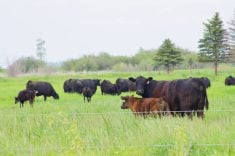Corn silage has a new northern home near Saskatoon.
Corn silage is not normally thought of as a forage crop for cattle producers north of 50 degrees latitude.
But 50 kilometres north of 52 degrees, near Broderick, Sask., the Fuglerud Ranch is enjoying success with ensiled corn this winter.
Dennis Fuglerud wanted to expand his cow-calf operation, but didn’t want the cost of additional land in the process.
Backgrounding 300 calves annually, as well as carrying an equal number of cows and heifers, he knew he had to change the amount of silage he could put up each year.
Read Also

House ag committee to undertake several studies
The House of Commons standing agriculture committee has set its agenda for the coming months. Members began the fall sitting with a two-hour update on international trade
“Corn appeared to be good way of doubling the amount of feed without doubling the land base,” he said.
After trying an experimental plot of corn, Fuglerud put in 100 acres of the crop last spring. Forty acres were planted under irrigation and 60 on dryland.
“The irrigated land is pretty light. It’s sandy and not too productive. The dryland field is pretty good though,” he said.
He hired a corn planter to put in the crop of Pioneer 39T67 at 30,000 seeds per acre and fertilized both fields to recommended rates. Fuglerud said the only difficulty he had with the crop was keeping weeds under control.
“Any place we didn’t have good weed control, it showed up fast. It is really obvious where there were weeds because there wasn’t any corn.
“Mostly we had corn, so we did have pretty good weed control,” he said.
The result was 14 tonnes to the acre of corn silage, with both irrigation and dryland yielding equally.
“Barley got us about eight tonnes (per acre). This is nearly twice that and with better feeding value.”
Fuglerud said the cost of production per tonne was similar to barley, with corn at $20 per tonne versus barley’s $14.
“Without the land cost and the cost of seeding and managing additional acres, this is a way for us to expand without climbing in the truck and driving to some new piece of land 15 or 20 miles away,” he said.
The 1,400 tonnes of silage supplements pasture and swath grazing and for about 60 days is the winter feed for ranch.
While each region of the Prairies is different, this area receives an average of 2,350 heat units. The corn variety he chose requires just 2,200.
“Nine years out of 10 we get at least the 2,200 and that should be enough to grow the corn,” he said.
The ranch is at the north end of the Outlook, Sask., irrigation district and because of that, the family can generally count on being able to buy good quality hay for $60 per tonne. In a year when corn fails due to hail or other weather problems, Fuglerud plans to supplement with hay.
“Hail can end a barley crop too, so I think the move to corn is one that we will be sticking with.”
Protein levels on the corn were lower than with barley. The corn was seven percent while barley could be expected to yield about nine.
Another benefit that Fuglerud is enjoying this winter is not having to add grain as a supplement to his corn silage in the mix wagon.
“It’s a ration on its own. With barley, we add a grain supplement. It isn’t a large cost, but it adds to the labour and it’s one more stop in the feed yard with each trip out to the pasture. In the middle of winter there aren’t too many producers that wouldn’t say that’s worth something too.”
















